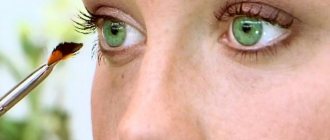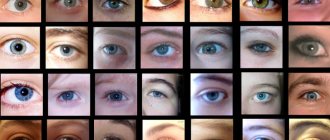Many parents are concerned about the eye color of their unborn child. Will the baby, like dad, charm everyone with his bottomless blue eyes, or will he take after his brown-eyed mother?
Why can eye shades differ between siblings? And in general, why do children change eye color?
There are so many different whys and whens... We will try to answer them in this article.
Signs of pathologies by eye color
All children inherit half the chromosome set from their parents.
A child gets 23 chromosomes out of 46 from his father and the same number from his mother. In addition to the inheritance of external characteristics - eye color, hair, constitution, the likelihood and predisposition to certain diseases is also inherited. Changes in the color of the iris may indicate the following pathologies:
- Heterochromia is one of the symptoms of Waardenburg syndrome. In addition to different shades of the eyes, the patient has thick fused eyebrows, a raised, wide nasal bridge, dental anomalies, short stature, impaired development of internal organs, hearing loss, and pathologies of the joints of the arms and legs. The anomaly occurs against the background of a spontaneous gene mutation and is often inherited.
- Cataract. After 50–60 years of age, brown-eyed people have a higher risk of developing cataracts than blue-eyed and gray-eyed people.
- People with dark eyes are less likely to get melanoma, a skin cancer. The pigment that colors not only the iris, but also hair and skin in a dark shade, is more abundant in the body of such people. It protects a person from exposure to ultraviolet radiation and reduces the risk of atypical cell degeneration.
- Blue-eyed people, especially those with red hair, are more susceptible to type 1 diabetes.
- Fuka's iridocyclitis. It manifests itself as heterochromia, weakened visual acuity, flickering spots and double vision. Increases the risk of developing glaucoma and cataracts and occurs most often at a young age.
- Hepatitis and other liver diseases. This pathology is characterized by yellow whites (sclera), yellow skin tone, and abdominal pain.
- Injuries to the organs of vision. Any mechanical impact on the eye can disrupt the synthesis of melanin, resulting in the iris becoming lighter or darker.
Brown-eyed people over 55 have a higher risk of developing cataracts
An interesting study was also conducted with the participation of 12,000 women and men. It turned out that people with blue and light gray eyes are more prone to alcoholism. This fact can be explained from a scientific point of view. The sensitivity of brain cells to alcohol-containing drinks is higher in those people who have high levels of melanin and, accordingly, dark hair and eyes.
Already at the stage of pregnancy planning, parents with a probability of 50–99% can predict what the shade of the eyes of the common child will be. But we cannot exclude the influence of genes from distant blood relatives.
Find out more on the topic: Childhood diseases
What color are the eyes of newborns?
The visible color of the cornea is primarily determined by its melanin content. This is a pigment that colors people's skin and hair dark. This is why Caucasian children are often born with blue, gray, green or blue eyes. These shades are obtained with a small amount of pigment. Over time, the color may change or remain the same as at birth.
The iris plays an important role for the visual system, but its color does not affect vision
The eyes of newborns can be the following shades:
- Blue. Most common among European children. This color occurs when melanin is practically absent. They tend to change several times during the first year of life, and sometimes later. Albinos most often retain a blue tint throughout their lives.
- Blue. A more saturated color compared to blue, it is less common. Determined by the property of reflecting blue light rays. Most often, such eyes are found among residents of the northern regions.
- Brown. From a scientific point of view, brown eyes are a dominant trait. Therefore, this color is more common among many peoples of the world.
- Black. They are quite rare in a newborn baby. This color of the iris is characteristic of Negroids and Mongoloids. At the same time, the structure of the eye shell is almost no different from those with brown shades.
- Green. Rich color is a rarity. Green shades are due to the presence of an additional pigment - lipofuscin. Most often, the eyes are not pure green, but olive, marsh, brown-green. A child's eyes may darken over time, acquiring a more brown tint. But the presence of lipofuscin from birth most likely means that it will not disappear with age.
- Gray. This is the closest shade to blue. This coloring is obtained if a small amount of melanin and other pigment substances is present.
- Dark gray. Compared to grays, they suggest a larger amount of melanin. They are quite common in adults, but rare in infants. Eyes may change color towards brown or remain unchanged.
- Yellow. They are very rare. This shade is usually called amber. The most common color seen is yellow-brown. A similar color is obtained by combining melanin with lipofuscin (green pigment).
- Reds. The color indicates the complete absence of melanin in the human body. Occurs in albinos. The red tint is given by capillaries that are visible through the transparent membrane of the eye.
A fairly rare phenomenon is heterochromia. This concept is used in cases where the eyes have different colors or one cornea is colored in areas of different colors.
Photo gallery: what is the eye color of young children
Blue eyes are most common in newborns of European nationalities
Blue eyes appear deeper and more thoughtful
Brown eyes develop early, often by the age of one year the color becomes permanent.
Black eye color is found mainly in dark-skinned peoples
Rich green eye color is rare
Gray color in infancy may persist or later change towards brown
Heterochromia in newborns is a rare phenomenon; with age, the eyes can become identical
When does a newborn's eye color change and why?
With the birth of a child, many people wonder what the baby is like. Everyone peers at the baby’s facial features, trying to catch his resemblance to someone else. Most new parents do not know when the eye color of a newborn changes and what it is connected with. It is necessary to take into account the fact that the child does not look exactly as many previously imagined. Some time must pass for the baby to get used to the environment and begin to look familiar.
The structure of the organs of vision
A newborn baby may have an irregularly shaped head, an elongated body and a protruding tummy. It happens that babies' breasts swell and fluid comes out. Such processes are quite normal for both girls and boys. But after a few days after birth, everything returns to normal. Even the nose may be slightly upturned at first, but after a while it acquires its permanent shape. But most people are interested in the question of when the eye color of a newborn changes. Why is this happening? The structure and structure of the visual organs of a newborn, as in adults. It is a kind of camera that contains the optic nerves. They serve as conductors of information to those parts of the human brain that perceive and analyze what it sees. The eye itself is divided into a “lens” (the cornea and lens) and a “film” (the retina). Although babies have the same organs of vision as adults, at first they still do not see very well.
As a child grows, his perception process also improves. A one-year-old baby's visual acuity reaches half the normal level of an adult. In the first week of life, the baby should only respond to light. On the second, fix your gaze on some object for several seconds. In the second month, this reaction should be more persistent. At six months, the baby can already distinguish simple figures, and at one year, he can recognize certain patterns.
When does a newborn's eye color change?
Newborns' eye color changes at different times. This process is directly related to the production of melanin. This is the pigment of the iris of the organs of vision. If you look closely at the color of the eyes of newborns, you will notice that most of them are blue. And only by the age of two or three do they acquire their final color. This is the time when melanin appears. It is for this reason that light eyes can turn into green, gray and even brown. The darker the color, the more of this pigment has accumulated. This process is directly related to heredity. Research shows that there are many more brown-eyed people on Earth than light-eyed people. This is due to the genetic dominance of traits. Therefore, if one of the parents is brown-eyed, then when the color of the newborn’s eyes changes, it most often turns out to be brown.
Features of light-eyed people
People who have light eyes are subject to frequent changes in their color. This may depend on the brightness of the lighting, clothing and their surroundings. Even a stressful situation or illness can affect their color. Now we know when the eye color of a newborn changes. For some this moment is very important, but for others it does not play any role. In fact, the main thing is that the baby grows up healthy!
Mystery of nature
Can the change in eye color in babies be considered a mystery? No, in fact, this process has long been explained by scientists. Another question is that no research allows us to determine in advance how it will ultimately turn out. Of course, you can make assumptions, but give no guarantee. And this despite the fact that scientists have been struggling with the mystery for centuries.
One thing can be said more or less accurately. Most often, a newborn baby has blue eyes. However, lovers of this color should know that the change will not be long in coming, because there are much fewer large blue-eyed children than babies.
When does eye color change in newborn babies?
The formation of the iris and its coloring occurs in the prenatal period around 8–10 weeks of fetal development. Newborn babies' eyes are almost always light, cloudy gray or green-blue.
The color change finally stops by the age of 5, depending on the characteristics of the child’s body, but already the infant exhibits dominant characteristics, which are determined by inheritance.
The process of changing the shade of the iris in infants is associated with the adaptation period and is determined by genetics. Already during the formation of the embryo, a genotype is laid down, transmitted from parents or more distant relatives.
During growth, the set of genes changes. Dominant ones always suppress recessive ones. Outwardly, this is manifested by darkening of hair, skin color, and eyes.
Before the color becomes permanent, it may darken or lighten.
More often the final color is darker:
- In children with blue or light green eyes at birth, the shade may change to dark gray;
- blue-eyed children usually retain this light into adulthood;
- If a child is born brown-eyed, then the color of the iris does not change with age.
In brown-eyed babies, eye color does not change with age
The intensity of synthesis and the final level of melanin are formed before 12–24 months of life. During this period, the pupil changes shade not only under the influence of dominant genes, but also when exposed to sunlight, diseases, and even changes in mood.
Eyes at birth and color changes
The color of the iris depends on the concentration of the melanin pigment. A large amount of it makes the eyes brown. If there is little pigment, the color is blue, green or gray. There is no need to worry if your newborn baby's eye color does not resemble his parents.
Almost all children are born with light sky blue eyes. The reason is that there is not yet enough melanin in the iris. After a few years, the baby's eye color changes - this happens by 2-3 years. The final color of the shell is formed. It depends on the following factors:
- speed of pigment production;
- the initial color of the newborn's eyes at birth;
- location of blood vessels;
- density of collagen fibers.
The period when baby's eye color changes can be individual and start faster or slower. For example, children with dark or dark skin to begin with have more melanin and their eyes are darker at birth. There are known cases where a child’s eye color changed by the age of 7-8 years.
Why do we need melanin?
All living organisms on the planet actively produce melanin. This concept refers to a pigment that can develop under the influence of ultraviolet rays.
When a child is in the womb, its contents are insignificant. When a baby is born, this value begins to actively progress. In total, several purposes of the pigment can be distinguished.
Protection of tissues from radiation damage
It is used in medicine to treat cancer, restore liver function and eliminate fatigue syndrome.
Premature value protection
Melanin is a unique substance. It can be independently synthesized in the human body in the form of a pigment, and it is also obtained artificially for various medical purposes. It is produced by each person in varying quantities, regardless of race, age and gender.
This pigment is found not only in the eyeball area, but also on other parts of the body. The color of skin and hair depends on it. A complete absence of melanin is extremely rare; rats are mostly affected by albinism
What color are the eyes of newborns?
The visible color of the cornea is primarily determined by its melanin content. This is a pigment that colors people's skin and hair dark. This is why Caucasian children are often born with blue, gray, green or blue eyes. These shades are obtained with a small amount of pigment. Over time, the color may change or remain the same as at birth.
The iris plays an important role for the visual system, but its color does not affect vision
The eyes of newborns can be the following shades:
- Blue. Most common among European children. This color occurs when melanin is practically absent. They tend to change several times during the first year of life, and sometimes later. Albinos most often retain a blue tint throughout their lives.
- Blue. A more saturated color compared to blue, it is less common. Determined by the property of reflecting blue light rays. Most often, such eyes are found among residents of the northern regions.
- Brown. From a scientific point of view, brown eyes are a dominant trait. Therefore, this color is more common among many peoples of the world.
- Black. They are quite rare in a newborn baby. This color of the iris is characteristic of Negroids and Mongoloids. At the same time, the structure of the eye shell is almost no different from those with brown shades.
- Green. Rich color is a rarity. Green shades are due to the presence of an additional pigment - lipofuscin. Most often, the eyes are not pure green, but olive, marsh, brown-green. A child's eyes may darken over time, acquiring a more brown tint. But the presence of lipofuscin from birth most likely means that it will not disappear with age.
- Gray. This is the closest shade to blue. This coloring is obtained if a small amount of melanin and other pigment substances is present.
- Dark gray. Compared to grays, they suggest a larger amount of melanin. They are quite common in adults, but rare in infants. Eyes may change color towards brown or remain unchanged.
- Yellow. They are very rare. This shade is usually called amber. The most common color seen is yellow-brown. A similar color is obtained by combining melanin with lipofuscin (green pigment).
- Reds. The color indicates the complete absence of melanin in the human body. Occurs in albinos. The red tint is given by capillaries that are visible through the transparent membrane of the eye.
A fairly rare phenomenon is heterochromia. This concept is used in cases where the eyes have different colors or one cornea is colored in areas of different colors.
What color will your child's eyes be?
After birth, the color of the newborn's eyes is gray-blue or blue with a glaze. This is explained by the fact that children have very little melanin pigment, which is responsible for the shade of the eyes, hair and skin. The more melanin produced, the darker your eyes, hair and skin will be. This pigment can accumulate only in light. But while the baby has not yet been born and is in the mother’s dark belly, melanin cannot accumulate. Therefore, all newborns have very similar light eyes.
When a baby is born, he opens his eyes and looks at the light. This starts the process of melanocyte production and melanin accumulation. When the baby has few melanocytes, the eyes will remain blue or blue. A little more accumulated pigment will produce a gray or green iris. If a lot of melanocytes are produced, the eyes will eventually be brown or black.
But this does not apply to everyone without exception. In certain newborns, the eyes may immediately be brown, mainly in dark-skinned and dark-skinned babies. Do these babies' eye colors change? No, the eyes of such children are unlikely to change dramatically. Only the shade may change, but the color itself will remain dark.
If the baby has yellow eyes, or more precisely, yellow sclera of the eyes, then this is a sign of neonatal jaundice. This is a physiological phenomenon that most children go through. It is associated with the imperfection of the baby’s liver enzymes. In this case, treatment is not required, but you must monitor the baby. If jaundice does not go away, then specialists must determine whether it is a disease or not.
When do babies' eyes change color?
When does eye color change in newborns? It is impossible to say exact dates, everything is individual. Up to 3 months, the baby’s iris remains fuzzy. Then the eyes become cleaner and gradually begin to acquire some shade. The time at which the baby’s eye color changes, earlier or later, is not an indicator and does not affect anything.
As a rule, color changes at 6-9 months, and not in one day, but slowly, gradually. As the year approaches, the shade becomes more saturated, or, conversely, lighter. Blue irises may gradually turn gray-green and then turn brown-green. Or, on the contrary, they may lighten and become blue. After a year, the color will not change dramatically, but it may become darker or lighter. Only by the age of 3, and sometimes later, a child’s eyes can become the same shade that they will have for the rest of their life.
What determines the color of a child's eyes?
The eye color of a newborn is entirely determined by genetic factors and is inherited. The darker the shade, the more dominant it is. Brown dominates everyone. Green has an advantage over blue and cyan. But this does not mean that brown-eyed parents cannot have a blue-eyed child. Mom and dad have two pairs of genes on each chromosome, and how they ultimately combine with each other determines what color the baby’s eyes will be.
Our inheritance table will help you understand more clearly how eye color is passed on from parents to children.
Most often in the world you meet people with brown eyes, and least often - with green eyes. It very rarely happens that a baby's eyes are different. This is called heterochromia and is not a sign of any disease. Albinos have red eyes. They have no melanin at all and the iris is transparent, the hair is white, and the skin is very light. But the blood vessels make the iris appear red.
Everyone's iris is unique and inimitable. It is impossible to predict in advance what a child’s eyes will be like. But rest assured that you will recognize your child’s favorite eyes from all the others!
Why does a child's eye color change?
Children, especially fair-skinned children, are born with light eyes because they have little melanin. Melanin is a type of pigment that gives color not only to the eyes, but also to the skin and hair.
"The amount of melanin in the iris determines what color the eyes will be," says Douglas Fredrick, MD, a pediatric ophthalmologist at Stanford Children's Health Center in Palo Alto, California.
It is genetics that is responsible for the amount of melanin in the body. It is the DNA that a child inherits from mom and dad that determines whether the eyes will be blue, brown, green, or another color.
Blue-eyed blond or brown-eyed brunette? What color will your child's eyes be?
A baby may be born blue-eyed (eyes sometimes don't produce much, if any, melanin while the baby is in the womb), but after birth, light stimulates melanin production, so the eyes may darken or change color.
According to Dr. Fredrik, there are no pigments in the eyes (blue, gray, green or hazel), with the exception of one - brown. It is its quantity that determines whether a person will be light-eyed or dark-eyed.
If we ignore science, there are various kinds of tables that help you find out how to correlate the eye color of the unborn child with its parents. According to these calculators, a brown-eyed mother and father will have a brown-eyed child. But not everything is so simple!
Dr. Fredrick says there are many genes in the body that affect eye color. Even if both parents have brown eyes, it is possible that the child will end up with blue eyes. How? Through grandparents and other generations. Therefore, if you and your partner have brown eyes, and your beloved daughter has green eyes, look for answers in the third generation and beyond.
Even if you've seen specific charts or accurate calculators, don't assume they're a 100% guarantee. "No one, including doctors, can predict exactly what color a child's eyes will be when they grow up," says Dr. Fredrick. It all depends on genetics alone.
One thing is at least clear: if a baby is born with brown eyes, this means that he already has a certain amount of melanin written in the genetic code, and therefore the eye color will not change.
Eye color pathologies
Common causes of changes in iris color are:
- Heterochromia is a pathology in which the color of the iris of one eye is different from the other or its parts.
- Glaucoma - the iris becomes cloudy and becomes lighter.
- Changes in the body's hormonal levels during puberty or illness. In this case, the color of the eyes may darken.
- Diseases of the central nervous system, such as Horner's syndrome, change the color of the iris to a lighter color.
- Inflammatory diseases - the eye acquires a greenish tint.
- Foods change eye color in newborns when the body's rate of production of the pigment melanin changes.
Amino acids contribute to this:
- Beta carotene.
- Tyrosine and tryptophan.
- Vitamin E.
- Selenium.
- Lycopene.
Heterochromia in children
Heterochromia is a rare hereditary pathology of the color of the iris, occurring in only 1% of the population. This is the result of a total or local change in the amount of melanin in the iris.
The simple form of heterochromia does not change vision. Complicated, in turn, affects the ability to see, manifesting itself: atrophy of the iris, clouding of the lens, cataracts, loss of visual fields.
Classification of heterochromia:
- Congenital and acquired.
- Abnormal darkening and lightening of the iris.
- Complete, sector and central heterochromia.
The cause of heterochromia can be a previous disease that has affected the pigment system in the organs of vision, as well as medications used to treat eye diseases, but most often it is a genetic predisposition.
In the case of acquired heterochrony, restoration of the same eye color is quite acceptable. It has been statistically proven that heterochromia occurs more often in females.
Albinism
Albinism is a disorder characterized by the absence of melanin in the body. This is a genomic change that occurs in 1 in 10,000 newborns worldwide. This violation is not tied to a specific nationality.
If only one in a couple has the albinism gene, the likelihood of having a healthy child is high. If there are two, the child will be an albino in 100% of cases. Albinism is associated with marriages between immediate family members. The main cause of the pathology is the absence of tyrosinase.
Aniridia
Aniridia is a disease characterized by the absence of the iris. This rare pathology occurs in 1 in 70,000 people. The pathology affects vision; in severe cases, the disease leads to complete blindness.
There are 2 types of aniridia: congenital and acquired:
- The formation of acquired aniridia occurs due to eye injuries: penetrating wounds and blows.
- Congenital aniridia occurs as a result of a mutation in the PAX-6 gene on chromosome 11. With a dominant type of inheritance, the probability of occurrence is 50%; with recessive inheritance, the disease can appear in 25% of cases, but then aniridia is accompanied by mental retardation of varying degrees.
In addition to the absence of the iris, the channels contribute to disruption of the circulation of intraocular fluid. This affects the increase in intraocular pressure. The retina of the eye is subjected to excessive irritation, because of this twilight adaptation suffers, and visual acuity decreases. In addition to the listed disorders, nystagmus is formed - uncontrollable twitching of the eyes.
What factors affect eye color?
Eye color in children is determined by how melanin is distributed. Because of this, the iris protects the visual organs well from sunlight. Light eyes may become lighter if the pigment fades. Brown eyes protect better from the sun, but residents of the Far North also have brown eyes to protect them from white snow.
It is impossible to determine the eye color of a newborn with 100% accuracy, because there are exceptions and genetic failures. The table shows the forecast of the baby's eye color depending on what kind of eyes the parents have. The figures given are the probability as a percentage.
| Parents/child eye color | Brown | Greens | Blue |
| Blue + light blue | 0 | 1 | 99 |
| Green + brown | 50 | 37,5 | 12,5 |
| Blue + brown | 50 | 0 | 50 |
| Green + green | Up to 1 | 75 | 25 |
| Green + blue | 0 | 50 | 50 |
| Brown + brown | 75 | 18,75 | 6,25 |
Eye color, which appears several years after birth, is determined by two genes with two copies. The combination of copies gives coloring - how long this will take after the birth of the newborn cannot be said for sure. In 90% of cases, children already go to school with a fully formed color.
The role of melanin in eye color
Children of other races are almost always born with dark eyes. But Caucasian (white) babies are usually born with dark blue eyes with a hint of gray and delight their parents until their first birthday, when their color changes forever.
The color of the baby's eyes gradually changes over time after birth. What causes a child's eye color to change?
The answer to this question is the melanin present in the iris of the eye, which the child inherits from his parents and some other factors.
Melanin is the pigment that determines the color of our
- skin
- hair
- and eyes.
It reacts to sunlight, causing the skin to be affected by changes in the intensity of the sun's rays to become darker, and the same happens to the iris, which can lead to changes in eye color in very young children. For blue eyes, a small amount of melanin is sufficient. Add a little more and your eyes will get a tint
- green
- gray
- or nutty.
A little more melanin and the eyes will turn dark brown or black.
Why can light-eyed parents give birth to a brown-eyed baby?
Are you expecting a new addition to your family, are you preparing for this event, are you thinking about who your baby will be like, whose traits he will inherit, his mother’s or his father’s? Or maybe grandparents or even more distant relatives? Usually, the facial features of a child immediately after his birth can already give an idea of who gave his appearance to the newborn. Nose, lips, hair, eye shape... but with the color of these same eyes, everything may not be so clear.
According to the results of research by the Russian doctor and anthropologist I. I. Pantyukhov, first published in 1909, at the beginning of the last century, half of the population of our country had gray eyes, a quarter had brown eyes, a fifth had blue or blue eyes, and only five percent had black and blue eyes. green.
In the middle of the 20th century, geneticists and anthropologists carried out serious research to identify a number of genetic hereditary traits in the population of our country. In particular, during the expedition led by Professor V.V. Bunak in 1955–1959, more than 17,000 people were examined. As a result, a table of eye color was compiled, from which it followed that the ratio of light-eyed men and women to dark-eyed ones was approximately six to one.
But as you know from a school biology course, darker eyes are dominant, that is, if one of the parents has brown eyes, there is a high probability that the child will inherit this particular iris color. And although the dominant trait usually suppresses the recessive trait, it cannot completely block it. And after a generation, light-eyed parents may have a baby with a grandmother’s searing black eyes.
It is impossible to definitely calculate the shade of a baby's eyes based on the eye color of his parents and grandparents - there are too many options. Yes, brown, as a rule, powerfully prevails over green, which, in turn, suppresses blue and gray. It turns out that the color of a baby’s eyes depends on the amount of melanin, a special pigment found in the iris. Complex processes of absorption of light rays contribute to the synthesis of melamine and the formation of eye color.
What influences this?
The color of the iris depends on heredity: the genetic makeup of parents and close relatives determines the intensity of melanin accumulation. Scientists can predict the color of a baby's iris thanks to Mendel's law. Its essence is that dark pigments are dominant genes.
There are certain rules of inheritance:
- If the father and mother have dark eye color, it is highly likely that the child will be born brown-eyed or black-eyed.
- Bright-eyed parents give their baby the same eyes.
- If the mother or father has dark eyes, and the other parent has light eyes, then the child can take on either a dark or an intermediate color of the iris.
The nationality of the parents and skin color are also important. If the father and mother are, for example, Asian in appearance, their child will inherit dark eye color. And among native Europeans, most often a baby is born with light eyes. Nationality and heredity determine the amount of pigment in the iris, which is why the baby acquires a certain amount of melanin.
In what cases can a child's eye color differ from the eye color of his parents?
Are you expecting a new addition to your family, are you preparing for this event, are you thinking about who your baby will be like, whose traits he will inherit, his mother’s or his father’s? Or maybe grandparents or even more distant relatives? Usually, the facial features of a child immediately after his birth can already give an idea of who gave his appearance to the newborn. Nose, lips, hair, eye shape... but with the color of these same eyes, everything may not be so clear.
According to the results of research by the Russian doctor and anthropologist I. I. Pantyukhov, first published in 1909, at the beginning of the last century, half of the population of our country had gray eyes, a quarter had brown eyes, a fifth had blue or blue eyes, and only five percent had black and blue eyes. green.
In the middle of the 20th century, geneticists and anthropologists carried out serious research to identify a number of genetic hereditary traits in the population of our country. In particular, during the expedition led by Professor V.V. Bunak in 1955–1959, more than 17,000 people were examined. As a result, a table of eye color was compiled, from which it followed that the ratio of light-eyed men and women to dark-eyed ones was approximately six to one.
But as you know from a school biology course, darker eyes are dominant, that is, if one of the parents has brown eyes, there is a high probability that the child will inherit this particular iris color. And although the dominant trait usually suppresses the recessive trait, it cannot completely block it. And after a generation, light-eyed parents may have a baby with a grandmother’s searing black eyes.
It is impossible to definitely calculate the shade of a baby's eyes based on the eye color of his parents and grandparents - there are too many options. Yes, brown, as a rule, powerfully prevails over green, which, in turn, suppresses blue and gray. It turns out that the color of a baby’s eyes depends on the amount of melanin, a special pigment found in the iris. Complex processes of absorption of light rays contribute to the synthesis of melamine and the formation of eye color.
Genetic characteristics of a child's eye color
Know! Heredity determines the appearance of a child, including the shade of his eyes. In this case, a child can inherit not only the traits of his parents, but also his closest relatives.
Recent research by scientists suggests the existence of at least six genes that influence the color of the iris. They can be divided into two types:
- dominant – give a dark shade,
- recessive - give light.
Dominant genes predominate over recessive ones.
Thus, if one parent is brown and the other is green, then the child will most likely inherit the darker brown color.
But in reality, the genetics of the color of the visual organs is much more complex, so their combinations depend on many factors.
It is worth noting! The probable shade of a child’s eyes can be determined based on the following data:
- if both parents have blue eyes, in 99% of cases the child will inherit the same iris color,
- a combination of green and brown shades guarantees a child’s brown color by 50%, green by 37% and blue by only 13%,
- parents with brown and blue eyes have the same chance of passing on their trait to their child,
- parents with green irises will give their child their shade with a 75% probability, 25% remains for the appearance of a blue shade and 1% for a brown color,
- green and blue can give both the first and second option and exclude the appearance of brown eyes in the baby,
- Brown eyes of both parents account for 75% of the appearance of brown shades in the baby, 18% of cases account for the appearance of green and 7% of blue.
What determines eye color?
The main factor that influences this parameter is heredity. If a baby's parents have the same eye color, there is a high chance that it will be passed on to the newborn.
If the mother and father have different iris colors, then the child will most likely inherit the darker one. For example, if one parent has brown eyes and the other has green eyes, then most likely their baby will have brown irises in the future.
The same principle works with animals. Although representatives of most species and specific breeds most often have the same eye color, any deviations are unique cases.
Eyes of different colors
Interesting fact : purple is considered the rarest eye color, so much so that 99.9% of people on the planet have never met its carriers in person. Purple color is obtained by mixing red and blue pigments. Biologists consider such eyes to be a subspecies of blue tint.
Scientists have also found that about ten thousand years ago, all people had brown eyes because they lived in certain areas with a fixed climate.
Interesting: Why does wax form in the ears?
How to determine color?
When a baby is born, many parents begin to wonder what shade their baby's eyes will have. The amount of melanin is determined before birth and is deposited at the end of the first trimester of pregnancy.
There are patterns that will help parents predict the eye color of their infants:
- If both parents have blue irises, 99% of the time a child will be born with blue eyes.
- If the father and mother have brown irises, in 75% of cases the baby will be brown-eyed, in 18% - green-eyed, and in 7% - blue-eyed.
- If both parents have a green iris, in 75% of cases the newborn will have the same shade, in 24% - blue, and in 1% - brown.
- If one parent has blue eyes and the other has green eyes, the baby will inherit either a blue or green iris.
- If one parent has green eyes and the other has brown eyes, the child should be brown-eyed in 50% of cases, green-eyed in 37%, and blue-eyed in 13% of cases.
- If the father or mother has a dark iris, and the other parent has a blue one, the baby will be born with either brown eyes or blue eyes.
Of course, such patterns are speculative, and in some cases the child inherits eye color despite them.
Gradually, when the pigment finishes accumulating in the iris, you can determine exactly what color the baby will have. If after 6 months the shade of the iris does not change from blue-gray, it is highly likely that the child will become light-eyed. If after six months the eye color begins to darken, most likely the baby will be brown-eyed.
There are cases when a baby has a congenital absence of pigment in the iris, which is why the child has a reddish eye color. There is no need to be afraid of this; this phenomenon is called albinism and does not pose a threat to the baby’s vision. The red iris is due to the transillumination of the blood vessels. In an albino adult, the eye color changes to a light blue tint.
How and why
Surprisingly, the iris of the unborn baby begins to form at 11 weeks. And from this moment on, the eye color has already been determined. However, it will not be possible to find out exactly what it will be soon, only when the shade finishes changing. Why is the eye color of newborns so inconsistent?
A special pigment, melanin, is responsible for the color of human eyes. It is the quantity that determines whether the child will have black or blue eyes. Accordingly, if there is a lot of melanin, then the first option will be obtained, if there is little - the second.
The same applies to brown, gray, green colors. But the fact that at birth babies usually have eyes of a very similar shade - either dull blue or dull gray - is explained by the complete absence of this same melanin in the iris.
The color begins to change at the moment when melanin synthesis starts in the body. When this can begin and how it ends depends solely on heredity.
What color are the eyes of newborns?
The visible color of the cornea is primarily determined by its melanin content. This is a pigment that colors people's skin and hair dark. This is why Caucasian children are often born with blue, gray, green or blue eyes. These shades are obtained with a small amount of pigment. Over time, the color may change or remain the same as at birth.
Eyes can only change shade towards darker. An iris that is brown or black at birth will most likely retain its original color in the future.
The iris plays an important role for the visual system, but its color does not affect vision
The eyes of newborns can be the following shades:
- Blue. Most common among European children. This color occurs when melanin is practically absent. They tend to change several times during the first year of life, and sometimes later. Albinos most often retain a blue tint throughout their lives.
- Blue. A more saturated color compared to blue, it is less common. Determined by the property of reflecting blue light rays. Most often, such eyes are found among residents of the northern regions.
- Brown. From a scientific point of view, brown eyes are a dominant trait. Therefore, this color is more common among many peoples of the world.
- Black. They are quite rare in a newborn baby. This color of the iris is characteristic of Negroids and Mongoloids. At the same time, the structure of the eye shell is almost no different from those with brown shades.
- Green. Rich color is a rarity. Green shades are due to the presence of an additional pigment - lipofuscin. Most often, the eyes are not pure green, but olive, marsh, brown-green. A child's eyes may darken over time, acquiring a more brown tint. But the presence of lipofuscin from birth most likely means that it will not disappear with age.
- Gray. This is the closest shade to blue. This coloring is obtained if a small amount of melanin and other pigment substances is present.
- Dark gray. Compared to grays, they suggest a larger amount of melanin. They are quite common in adults, but rare in infants. Eyes may change color towards brown or remain unchanged.
- Yellow. They are very rare. This shade is usually called amber. The most common color seen is yellow-brown. A similar color is obtained by combining melanin with lipofuscin (green pigment).
- Reds. The color indicates the complete absence of melanin in the human body. Occurs in albinos. The red tint is given by capillaries that are visible through the transparent membrane of the eye.
A fairly rare phenomenon is heterochromia. This concept is used in cases where the eyes have different colors or one cornea is colored in areas of different colors.
For what type of vision is disability given in Russia?
- curvature and turbidity of the crystal;
- defects of the eye muscles;
- mutational abnormalities;
- impaired homogeneity of the vitreous body;
- the presence of dysfunction of the optic nerve due to impaired cerebral circulation;
- blood pressure surges;
- decreased vision due to diabetes mellitus;
- dysfunction caused by microbial/viral diseases.
Basic conditions:
- impossibility of moving without the help of third parties;
- impaired ability to communicate;
- lack of spatial orientation ability;
- lack of training opportunities;
- employment problems;
- loss of self-control.










